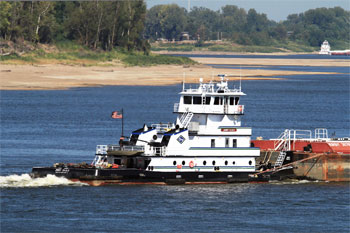The Midwest’s worst drought in decades has resulted in a complicated and costly shipping season for companies operating on the Mississippi River.
Water levels remained low throughout the summer months, reaching record lows in Memphis, Tenn., Vicksburg, Miss., and New Orleans in August. In response, the U.S. Coast Guard issued a low-water advisory and imposed a barge draft limit of 9 feet in comparison to the usual 12 feet. Following Hurricane Isaac, the Coast Guard briefly eased the draft limit to 10 feet before reinstating the 9-foot restriction in early September. A low-water advisory was still in place as of Oct. 18.
To comply with restrictions, tug and tow operators were lightening their loads and traveling more slowly, measures that increase costs.
The American Waterways Operators (AWO) estimates that losing one foot of draft forces vessel operators to lighten the loads by 204 tons of cargo capacity per barge.
“When you consider that a typical tow on the Mississippi or Ohio River has 15 barges, a one-foot loss of draft will decrease the capacity of that tow by 3,000 tons,” explained Ann McCulloch, director of public affairs at AWO. “The larger tows on the lower Mississippi that would normally be pushing 40 to 45 barges are now only pushing 25 to 30.”
When vessels risk a passage in a low-water area, stoppages can occur. The Coast Guard reported that about 60 groundings have occurred this year, a figure near the average, but low-water conditions make it more difficult to refloat grounded vessels. On Aug. 22, the grounding of a barge at the 11-mile channel near Greenville, Miss., caused a three-day snarl that delayed over 100 ships.
The costs add up quickly, noted McCulloch: Barge operators lose an estimated $10,000 per day when sitting in queue.
To moderate the drought’s effects, the U.S. Army Corps of Engineers has been dredging the channel and river ports.
“While the main channel has held up pretty well, the harbors took the brunt of the siltation during last year’s floods. So it has been particularly difficult to dredge the harbors sufficiently and keep the ports open,” said Bob Anderson, regional chief of public affairs for the Corps’ Mississippi Valley Division.
As of early September, three of the river’s 16 ports were still closed — Phillips County, Ark., Helena, Ark., and Northwest, Tenn.
The Mississippi is not the only region affected by drought this summer; low-water conditions on the St. Lawrence Seaway have caused problems for vessel operators. In June, the Seaway responded by decreasing the maximum draft from 26 feet 6 inches to 26 feet 3 inches and advising mariners to move at the slowest safe speed.
Though conditions are less severe than on the Mississippi, shipping has been affected. “We’ve had to load 300 tons less than what we would usually carry on a 25,000-ton load,” said Canadian Shipowners Association head Robert Lewis-Manning.
Ships have also been reducing their speed, said Capt. Michel Fortin, president of the Corporation des Pilotes du Saint-Laurent Central: “In order to maximize our cargo, we had to go 2 to 3 knots slower,” he said.
It’s difficult to determine how much the drought has cost due to the many ways it impacts the shipping industry. The stoppage at Greenville resulted in nearly $3 million in lost revenues in three days. It’s less easy to estimate the cost of the lighter loads that cargo companies have been forced to carry to stay afloat.
Many have used 1988 as a reference point, when the shipping industry lost an estimated $1 billion to a similar drought. “The longer this continues, the closer it comes to that year,” said McCulloch. “Despite the boost created by Hurricane Isaac, operators still aren’t in the clear, and all signs suggest that low-water conditions will impact vessel owners for several weeks into the fall.”

